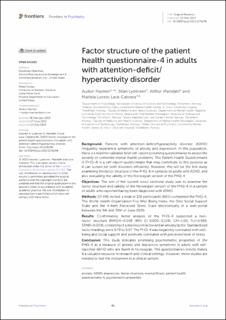| dc.contributor.author | Havnen, Audun | |
| dc.contributor.author | Lydersen, Stian | |
| dc.contributor.author | Mandahl, Arthur | |
| dc.contributor.author | Lara Cabrera, Mariela Loreto | |
| dc.date.accessioned | 2023-11-07T08:28:45Z | |
| dc.date.available | 2023-11-07T08:28:45Z | |
| dc.date.created | 2023-08-30T11:40:55Z | |
| dc.date.issued | 2023 | |
| dc.identifier.issn | 1664-0640 | |
| dc.identifier.uri | https://hdl.handle.net/11250/3100960 | |
| dc.description.abstract | Background: Persons with attention-deficit/hyperactivity disorder (ADHD) frequently experience symptoms of anxiety and depression. In this population, there is a need for validated brief self-report screening questionnaires to assess the severity of comorbid mental health problems. The Patient Health Questionnaire 4 (PHQ-4) is a self-report questionnaire that may contribute to this purpose as it can screen for both disorders efficiently. However, this will be the first study examining the factor structure of the PHQ-4 in samples of adults with ADHD, and also evaluating the validity of the Norwegian version of the PHQ-4.
Objectives: The aim of the current cross-sectional study was to examine the factor structure and validity of the Norwegian version of the PHQ-4 in a sample of adults who reported having been diagnosed with ADHD.
Methods: Of 496 invited, a total of 326 participants (66%) completed the PHQ-4, The World Health Organization Five Well-Being Index, the Oslo Social Support Scale and the 4-item Perceived Stress Scale electronically in a web-portal between the 9th and 30th of June 2020.
Results: Confirmatory factor analysis of the PHQ-4 supported a two-factor structure [RMSEA = 0.038 (90% CI 0.000–0.159), CFI = 1.00, TLI = 0.999, SRMR = 0.004], consisting of a depression factor and an anxiety factor. Standardized factor loadings were 0.79 to 0.97. The PHQ-4 was negatively correlated with well-being and social support and positively correlated with perceived level of stress.
Conclusion: This study indicates promising psychometric properties of the PHQ-4 as a measure of anxiety and depressive symptoms in adults with self-reported ADHD who are fluent in Norwegian. The questionnaire’s brevity makes it a valuable resource in research and clinical settings. However, more studies are needed to test the instrument in a clinical sample. | en_US |
| dc.language.iso | eng | en_US |
| dc.publisher | Frontiers Media S. A. | en_US |
| dc.rights | Navngivelse 4.0 Internasjonal | * |
| dc.rights.uri | http://creativecommons.org/licenses/by/4.0/deed.no | * |
| dc.title | Factor structure of the patient health questionnaire-4 in adults with attention-deficit/hyperactivity disorder | en_US |
| dc.title.alternative | Factor structure of the patient health questionnaire-4 in adults with attention-deficit/hyperactivity disorder | en_US |
| dc.type | Peer reviewed | en_US |
| dc.type | Journal article | en_US |
| dc.description.version | publishedVersion | en_US |
| dc.source.volume | 14 | en_US |
| dc.source.journal | Frontiers in Psychiatry | en_US |
| dc.identifier.doi | 10.3389/fpsyt.2023.1176298 | |
| dc.identifier.cristin | 2170880 | |
| cristin.ispublished | true | |
| cristin.fulltext | original | |
| cristin.qualitycode | 1 | |

